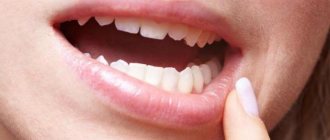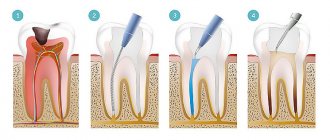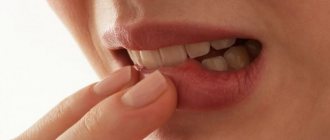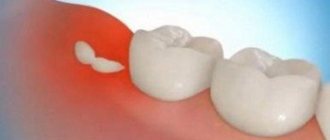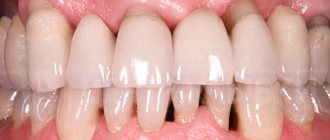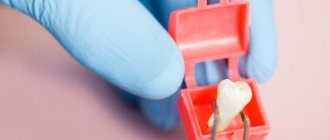Oral health
Usually the only thing that makes a person go to the dentist is toothache, which is absolutely wrong.
The health of your teeth is also determined by the condition of your gums. Their swelling indicates the progress of inflammation. You can eliminate unpleasant swelling by eliminating the causes of the pathological process. Biryukov Andrey Anatolievich
doctor implantologist orthopedic surgeon Graduated from Crimean Medical University. Institute in 1991. Specialization in therapeutic, surgical and orthopedic dentistry including implantology and implant prosthetics.
I believe that you can still save a lot on visits to the dentist. Of course I'm talking about dental care. After all, if you carefully care for them, then treatment may indeed not come to pass - it won’t be necessary. Microcracks and small caries on teeth can be removed with regular toothpaste. How? The so-called filling paste. For myself, I highlight Denta Seal. Try it too.
Factors in the formation of gum swelling
After treatment of a tooth, the gums may become swollen due to poorly sealed canals, perforation of the area, or trauma to the shell with instruments. As a result, the apex of the tooth root becomes covered with purulent inflammation granuloma, which can transform into a cyst and develop in the form of periodontitis. One of the reasons may also be incorrect installation of a filling, which puts pressure on the gums.
If your gums are inflamed, you should seek help from a dentist.
Often, swelling of the gums is detected after filling. Usually the phenomenon is temporary and goes away quickly. This is associated with the very fact of the procedure, the administration of a painkiller. A situation where the swelling does not subside and pain is added indicates that mistakes were made during treatment. We should not forget about possible allergies to anesthesia and medications that cause temporary swelling.
Normal duration of inflammatory response after dental procedures
If your gums hurt after canal filling, or after any other dental intervention, then in most cases this is not a reason to rush back to the dentist.
One or two days of soreness may well be a concern, since the likelihood is that the gum tissue was injured either during the installation of a rubber dam (a special latex plate that isolates the tooth that needs treatment from neighboring teeth and the oral cavity) or when the gum was touched by a drill.
Such injuries can cause pain and swelling, which, however, should stop bothering you quickly enough.
If such manifestations last more than two to three days, then there is a possibility that an infection has occurred, and it is advisable to visit the dentist in order to receive recommendations for further treatment (most likely this will be rinsing with antiseptic solutions).
It also often happens that unpleasant sensations in a tooth with a fresh filling are perceived as pain in the gums. The body just needs a certain time in order to adapt to a foreign object, which is the filling material.
Normally, the discomfort goes away within a few hours, but in particularly sensitive patients the discomfort can last more than a day.
After tooth extraction, the gums may hurt for several days, which is not surprising, because after this operation there is an open wound there. However, if pain and swelling persist for longer than two or three days, then this is still a reason to seek help from a dentist (it should also be taken into account that a number of diseases, for example diabetes, slow down the healing of wounds).
Treatment methods
A gum tumor can cause discomfort and pain. Pathology should not be treated on its own, as it may indicate the presence of a more complex dental problem. If the cause is not determined, it is recommended to consult a dentist and get the correct prescriptions. To alleviate unpleasant symptoms at home, you can use the following methods:
- rinsing the mouth with solutions of Chlorhexidine, manganese, peroxide, soda and salt;
- rinsing with a decoction of sage or chamomile. It is acceptable to use herbal remedies that have an anti-inflammatory and antimicrobial effect.
If rinsing does not bring the desired result, as prescribed by the doctor, they resort to taking the antibiotics Lincomycin, Ciprofloxacin, Tsifran, Amoxiclav or Ampiox.
Infusions and decoctions high in vitamins improve the general condition of the body. Tea with chamomile flowers, mint and thyme helps stop the inflammatory process.
Folk remedies can effectively treat gum disease
During the period of using folk remedies, it is necessary to strictly follow the rules of oral hygiene. If such treatment does not bring results after 3 applications, a visit to the dentist is required. Special gels that have an analgesic and antimicrobial effect can help reduce gum swelling:
Gels eliminate swelling and pain. They are used according to the instructions, applied to the affected areas with a finger or a cotton swab. Of the painkillers, Solpadeine, Ketanov, and Ketolong have a good effect. The following drugs are prescribed to relieve the inflammatory process:
Do you feel nervous before visiting the dentist?
For gingivitis in pregnant women, Heparin ointment and 3% acetylsalicylic acid ointment provide effective assistance.
Thus, the issue of tumor removal remains unresolved until the causes of its occurrence are discovered. Therefore, diagnostics are important. Sometimes during diagnosis, simultaneously occurring pathologies are missed, for example, the abscess of an abscess is removed, but the cyst present on the tooth remains unnoticed by the dentist.
Folk remedies
Many people do not know what to do with a swollen gum, what to do, how to treat it before visiting a doctor. The discomfort can be so severe that a person cannot eat or sleep normally. Folk remedies come to the rescue.
Herbal decoctions and solutions for rinsing gums
A decoction of calendula will help relieve swelling at home. The flowers of this medicinal plant have strong disinfectant and healing properties. A decoction of them removes inflammation and heals damaged tissue. Salt is added to the broth as it draws out the pus. It’s easy to prepare a rinse solution:
- For 50 g of flowers, take 350 ml of boiling water.
- Cook over low heat for 15 minutes.
- Add 15 g of salt and cook for another 5 minutes.
- Leave for 40-50 minutes and strain.
It is recommended to rinse your mouth with this solution at least 4 times a day. On the second day the condition improves.
It is recommended to rinse your mouth with a honey solution at least 3 times a day. Honey should be diluted in warm boiled water.
An infusion of rye bread crumb is an affordable remedy for pain relief. Break a slice of bread into 6-7 pieces and pour a glass of boiling water over it. Add 15 g of salt, leave for 5 minutes and cool. You need to rinse at least 4-5 times a day.
Rinsing with a decoction of chamomile, sage, St. John's wort, and linden shows excellent results. However, homemade herbal infusions contain pigment substances, as a result of which the enamel changes color. For each procedure, prepare a new solution (for 1 rinse you will need 200 ml of medicinal solution).
Lotions and compresses
In case of severe inflammation, you need to apply a paste of aloe and honey to the sore spot. Sometimes propolis tincture or lemon juice is rubbed into the gums.
Plantain heals damaged mucous membranes. Young and thoroughly washed leaves are chewed or crushed and applied to the diseased area.
Why does a tooth hurt after root canal filling?
Most patients go to the dentist only when their tooth hurts very badly and their cheek is swollen. As a rule, such symptoms indicate that caries has turned into pulpitis, and conventional filling will not be enough. First, the doctor will have to treat the pulp, and possibly remove the nerves, then clean the canals and put in a temporary filling. And only then, when the inflammation has been eliminated, can a permanent filling be installed, filling the dental canals along their entire length with the solution.
If the inflammation is eliminated and the entire procedure of filling the canals is carried out correctly, the patient does not hurt anything - this is logical. But in more than half of the cases, after treatment at the dentist and root canal filling, patients complain that the tooth hurts, throbs, twitches, and prevents them from sleeping or eating. Why does this happen, how long will the tooth hurt, is this normal and what should be done in such a situation?
Why does pain occur?
The pain syndrome that occurs after applying arsenic paste to a tooth indicates that the inflammatory process has affected healthy tissue. This phenomenon is often complicated by suppuration and sepsis.
Pain develops under the influence of several factors.
Dentist mistakes
There are two errors that lead to pain. The first is the incorrect dosage of the drug. In particular, arsenic, applied in insufficient quantities, is not able to destroy the entire nerve. Because of this error, the pathological process continues.
The second is the incorrect administration of the drug. If arsenic comes into contact with gum tissue, the latter becomes inflamed under the influence of the toxic substance. The result is pain.
Necrosis of bone tissue
It is considered the most severe consequence of surgery to remove the affected nerve. Necrosis of bone tissue occurs due to the toxic effect that arsenic has on it. This process can lead to its atrophy.
Why and how long does a tooth hurt after filling?
If a tooth hurts after root canal filling, this is a normal and quite expected occurrence. To gain access to the canals, the doctor first had to open them, that is, clean the tooth cavity of necrotic tissue. This is done using a drill, and the dental cavity is subjected to intense mechanical stress.
The cleaning of the canals itself is carried out using special tools - thin needle files with tips of various shapes. By manipulating these needles, the doctor cleans dead tissue and accumulations of bacteria from the walls of the canal. This is also an external influence to which the tooth cannot help but react.
In addition, there is also the treatment of the cavity and canals with antiseptics after cleansing, filling the voids with filling material - all these procedures can be quite noticeable and cause discomfort. Therefore, canal filling is often carried out under local anesthesia, and during all these manipulations the tooth does not hurt at all.
But when the effect of the anesthetic injection wears off, the tooth hurts and aches. This is a normal reaction; in addition to the fact that the tissues were treated with dental instruments, they still need to get used to the foreign body - the filling.
And this can take from several days to several weeks, depending on the individual characteristics of the patient. This is the answer to a very common question: how long can a tooth hurt after root canal filling?
When to be concerned
Pain can also be of different nature and intensity. And it depends on what they are and how long they last, whether you need to see a doctor, or whether the discomfort is natural and temporary and will go away in a few days on its own without treatment.
Normally, a tooth may bother you for up to 4 weeks after root canal filling. At the same time, every day the pain should become weaker and less frequent. You need to see a doctor if:
- the pain is not severe, but lasts more than 4 weeks;
- the pain lasts for several days, but does not weaken, but becomes more intense;
- aching pain is replaced by sharp, throbbing pain;
- the gums under the filled tooth are redder and swollen;
- body temperature rises and the patient’s general condition worsens.
In all these cases, you should not rely on folk remedies and painkillers. They help relieve only temporary discomfort caused by mechanical stress on dental tissues. You can rinse with soda, take analgin, Nise or Ketolorac, apply ice while the dentist is unavailable. But at the first opportunity you need to show yourself to him.
Why gums become inflamed after treatment: possible reasons
Minor inflammation after dental canal filling or other types of treatment is considered normal and does not require special therapy except for maintaining a hygienic regime. But if the inflammation does not go away on the second or third day, and is accompanied by severe pain, hyperemia of the mucous membranes, and swelling, the cause should be found out. It is not recommended to use anti-inflammatory and antibacterial drugs without consulting a dentist - self-medication can aggravate the problem and lead to progression of the pathology.
Allergic reaction
One of the most common causes of inflammation of the gum tissue is an allergy to medications used for local anesthesia. In this case, inflammation is manifested by severe local swelling at the injection site, redness and soreness of the tissue. An allergic reaction can also occur to the following groups of drugs used during dental procedures:
- hemostatics (hemostatic drugs, used mainly after extraction of a tooth from a bone alveolus);
- antibacterial drugs (placed in the tooth cavity when there are signs of an infectious process);
- antiseptics, which are used to disinfect dental canals;
- disinfectant solutions for sterilization of medical instruments;
- arsenic paste for killing the dental nerve (rarely used in modern dental practice).
Inflammation of the gums can occur as a result of an allergic reaction
In addition to swelling and redness, rashes in the form of small pale pink dots may appear on the mucous membranes of the gums, accompanied by itching and burning.
Allergy treatment involves the use of drugs from the group of histamine receptor blockers. Popular antihistamines, as well as their regimen, are listed in the table below.
| A drug | Image | Reception scheme | Cost (average values are indicated for packaging with a minimum volume) |
| "Claritin" | 10 mg 1 time per day, regardless of meals | 155 rubles | |
| "Loratadine" | 10 mg 1 time per day | 12 rubles | |
| "Erius" | 5 mg once a day at the same time | 224 rubles | |
| "Fenistil" | 20 drops in the morning during breakfast and 40 drops in the evening before bed | 356 rubles | |
| "Zodak" | 10 mg 1 time per day | 122 rubles | |
| "Tavegil" | 1 mg 2 times a day before meals | 145 rubles |
Important! All dosages in the table are indicated for adult patients and adolescents over 12 years of age. The regimen for use in childhood is selected individually.
Poor quality treatment
Errors during dental treatment can also lead to inflammation on the first or second day after the manipulations. The most common cause of such symptoms is infection of soft tissues as a result of pathogenic bacteria, fungi or viruses entering the damaged gum. To avoid this, you must follow all the dentist’s recommendations, especially in the first 72 hours after treatment. To prevent complications, which include inflammatory processes in the gums, the patient is recommended to:
- do not eat or drink for 2-8 hours after treatment (the final time depends on the type of therapy performed, the severity of the underlying diagnosis and the medications used);
- rinse your mouth with antiseptics or anti-inflammatory decoctions of chamomile, calendula or St. John's wort (on the first day it is better to do oral baths);
- take antimicrobial and antibacterial drugs if prescribed by a doctor;
- maintain a gentle hygiene regime so as not to injure your gums.
Poor treatment can cause gum inflammation
Important! In especially severe cases, inflammation can be triggered by a foreign body. This situation is possible when the special needles that are used to clean the canals break off. Symptoms of this pathology will be manifested by severe pain, swelling and swelling of the gums, severe hyperemia of the mucous membranes around the filled tooth. If such signs occur, you should immediately consult a doctor (if pain and inflammation appear at night, you can contact the emergency dentist).
Tooth injury during treatment
Damage to soft or hard tissue that may occur during the use of medical instruments can lead to the formation of cysts. Cysts are growths in the form of cavity sacs that have an oblong and elongated shape and are filled with exudative or purulent fluid. If the cyst is not treated in time, it can develop into a granuloma - a benign tumor of the dental root (located mainly at the apex of the root system).
Advanced dental cyst
Cysts can go undetected for a long time. They are characterized by a slow course with mildly expressed symptoms. During the formation of a cyst, the gums may look inflamed and hyperemic, but after a few days these signs disappear, and the person mistakenly thinks that everything is fine.
Important! If there are frequent inflammatory processes in the gums around the tooth that has been treated, it is necessary to consult a doctor and undergo an X-ray examination to exclude formations of various etiologies.
Video: Why gums become inflamed
Why can a tooth hurt after root canal filling?
So, what causes unbearable, shooting and tugging pain and swollen gums?
- Repeated caries or pulpitis. If necrotic tissue was not completely removed, if a piece of nerve remained in the canal, or if the infection spread from neighboring, not yet cured teeth, these pathologies may develop under the filling and cause pain.
- Tool fragment. The dentist himself may not notice that the needle has broken and a piece of its tip remains in the dental canal. Sometimes a person lives with it for months or even years, and only then the tooth becomes inflamed and hurts. To detect such a medical error, it is necessary to take an X-ray.
- Cyst. This neoplasm is also not always visible even on an x-ray if it is covered by large tooth roots. Very often, a granuloma or cyst is discovered only after tooth extraction, so there is no need to rush to accuse the doctor of incompetence or negligence.
- Burns to nerves and pulp while using a drill. Modern equipment is equipped with special cooling devices, since during prolonged cleaning with a drill, both the bur and the tooth tissue overheat. If they are not cooled with water, a burn of the pulp may occur, which is very painful and also threatens the development of inflammation.
- Insufficient or excessive filling of dental canals with filling solution. Both the first and the second are equally bad. In the first case, access is opened for bacteria to penetrate into the pulp and periosteum, in the second, cement or composite material removed outside the canals injures the soft and hard tissues of the tooth and also provokes inflammation. It can also be difficult to determine exactly how much filling composition is needed because many solutions shrink greatly after hardening.
What to do to get rid of pain? There is only one answer - make an appointment with the doctor again, take an x-ray and have the tooth re-treated.
Neither pulpitis, nor a fragment of a dentist's instrument, nor excess filling material will resolve on their own, and the more time passes, the more difficult and lengthy the treatment will be.
What is a temporary filling
A temporary filling is necessary to protect the tooth during the intermediate stage of treatment. Its composition is somewhat different from the constant one. The material has a consistency that makes removing the filling easy.
Temporary seal
A permanent filling, unlike a temporary one, is placed for a long period of time - at least three years, subject to the rules of oral hygiene. For minor problems, a permanent one is installed, without using intermediate steps with a temporary installation.
If a temporary filling occurs, then the problem of the diseased tooth is not simple. Infection, forced removal of nerves and other factors influence the decision to install a filling.
In order for the dentist to be confident in 100% high-quality treatment of a neglected tooth, he has to use this method. The intermediate stage with temporary filling can last up to 14 days, depending on the level of the problem. After this, a constant is set.
Reasons for using a temporary filling
The main reason is treatment or removal of the nerve. In the center of the dental bone there is a small collection of nerves, which is a connection between bone tissue and blood vessels. Inflammation of this collection of nerves is called pulpitis. Inflammation occurs due to advanced caries, which has “reached” the nerves. Severe pain and infection of other adjacent tissues in the oral cavity are the consequences of this disease if treatment is refused. The treatment concept involves removing the nerve, installing a temporary filling, and replacing it with a permanent one a few days later.
Treatment concept in removing a nerve from a tooth
Deep caries is another important point. Caries is an iceberg that looks like a small black dot from the outside, but when excavated you can find a fairly large affected area. After removing caries and diseased tissue, a temporary filling is placed, because it is almost impossible to determine immediately whether the dentist has gotten rid of the entire problem. Therefore, temporary filling is done. A week or two later, the patient comes to the clinic for a recheck, because a relapse is possible. If everything went well and no further infection is observed, a permanent filling is placed.
If a cyst is found. When infected foreign bodies enter the soft tissue of the root area, a cyst is formed. In order to penetrate the cyst, it is necessary to remove the accumulated fluid in this place and thoroughly disinfect the affected area. If this is not done, after some time the appearance of a new cyst is inevitable. Treatment occurs in several ways. Several stages of treatment include the introduction of a temporary filling, which at the last stage is replaced with a permanent one.
Causes of pain in teeth with temporary fillings
The main thing you need to know is that pain in teeth with such a filling is not a critical moment, and this is not a reason to urgently contact a dental center. It is worth remembering that this is an intermediate stage, and the final step is yet to come.
Temporary filling fell out
As written above, the cause may be a relapse. An incompletely treated problem can cause an unpleasant, aching pain. But the dentist is just a person, and an error could have occurred during the procedure. If this is not a continuation of the illness for which the patient went to the dentist, the reasons may be different.
- The seal was not made to the level. If the nerve is completely removed, this complication may occur. The places where the nerves were located are canals. Recently, a method has emerged to avoid this complexity. The channels are closed with an elastic soft font, and then only the filling occurs. But not all clinics have the opportunity to obtain this special material, and a filling is placed on the tooth. After filling the canals, it goes beyond the level of the top of the root. Next, the filling material may get on the surface of the mucosa. The body immediately begins to fight foreign bodies, and pain is one of its ways.
- Foreign bodies. This can only happen through the fault of the dentist. If the instruments are used incorrectly, a small chip of some instrument may occur, and this part will remain inside the tooth. If the doctor did not notice this during the procedure, this threatens inflammation with all the ensuing consequences. Pain in a filled tooth, itching, swelling of the gums, fever, etc. Before you decide to fill a tooth, you should work hard and find a professional.
- Root damage. Using a dental hammer requires special care. One uneven movement and the root may be broken. Neither the patient nor the doctor will notice this during the procedure, since there are no visible symptoms other than the damage itself, which may be tiny. But when the effect of the painkiller wears off, pain appears, and by the evening the gums swell.
- Incomplete nerve removal. When treating pulpitis, this mistake is very common. Nerves have long branches with many branches. And sometimes it is not possible to remove it completely. Part of the nerve remains in place. Pain comes almost immediately after filling a tooth. This nagging pain can continue for a long time. At the stage of replacing fillings, it is necessary to inform the dentist about the pain that has arisen so that he can check whether there are any nerve residues left in the tooth.
- Allergy. It’s trite, but for some reason it is always forgotten that a person may be allergic to any substance included in filling materials. This is manifested by the fact that this substance presses on the nerves of the soft tissues, which causes pain and may cause swelling of the gums. It seems that the tooth hurts, but it is the gums. After visiting the doctor, you need to ask to replace the filling with another one.
- Damage to the seal. The main recommendation when wearing a temporary filling is not to touch it with your tongue, finger or other household items, including a toothbrush. A temporary filling is a fragile thing that can be easily damaged or even lost altogether. When pain appears, the first thing you need to do is look in the mirror at the sore tooth and check for integrity and the presence of a filling.
- Negligent attitude to doctor's recommendations. Having received a prescription from the dentist, most patients believe that the job is done, and the drugs specified in the prescription are not such a necessity. But, these may not just be painkillers, but medications that act against the recurrence of infection, or special disinfecting gels.
What to do if your gums are swollen
Before you find out what to do, you need to know what is strictly forbidden to do:
- apply ice;
- prescribe medications for yourself, or on the advice of friends or a pharmacist;
- traditional medicine is also not welcome;
- strange methods found on the Internet, stay away.
What can you do if your gums are swollen and painful? Apply a cold gauze compress to your cheek, take medications prescribed by your dentist, call your dentist, explain the situation, and ask for advice. If you have doubts about the doctor’s qualifications, turn to another one.
Seeing a dentist immediately is the key to your oral health.
Swollen gums around the tooth
You should not sit idly by if you have the following signs: the gums are very swollen and have changed their color, there is weakness, a sharp increase in body temperature, a swollen cheek. An unpleasant purulent odor from the mouth and the appearance of pain when swallowing or chewing food are also not good indicators.
If your gums are swollen and you think that a temporary filling is to blame, do not hesitate, correct the situation by contacting a reputable doctor.
How to get rid of gum pain?
Unpleasant sensations in the gums in the first hours after dental treatment are normal. A good doctor will always warn the patient about such things after a dental procedure.
However, a distinction must be made between some discomfort and pain that is difficult to bear. Discomfort is characterized by unpleasant sensations, tingling, and sometimes slight pain in the treatment area during the first two days. The opposite is a state of unbearable pain, the inability to eat, rolling and throbbing pain. In this case, the patient cannot function normally: work or fall asleep.
Causes of pain after dental treatment
- Individual patient reaction to an anesthetic injection. Gums and soft tissues react differently to the action of the injected drug;
- Rejection of the installed filling. Soft tissues “do not accept” the filling installed by the doctor, signaling this with pain;
How to relieve gum pain at home
In any case, the patient is unlikely to be able to function normally, since the pain tends to increase: it becomes more frequent and more difficult for the person to bear. Therefore, it is better to visit the doctor again as soon as possible. If for some reason it is impossible to do this, then try to reduce the pain yourself.
- Try not to eat foods at high or excessively low temperatures. This will only aggravate the situation, since in the first time after treatment the gums are sensitive to external irritants;
- Brush your teeth only with a cool brush. There is a misconception that a warm toothbrush helps reduce gum pain. In fact, this will only increase the sensitivity of already inflamed tissues;
- Do not apply mechanical force to the gums. This applies to both the pressure applied when brushing your teeth and simple picking in your mouth out of curiosity. It is human nature to touch those places that hurt, so make sure that soft tissues are not touched by hands or other objects;
- Under no circumstances apply traditional painkillers or disinfectants to the gums - peppers, garlic, and so on.
- Rinse your mouth with a salt solution, a decoction of sage or chamomile. When rinsing, try to focus on the affected area. At the same time, do not forget that you should not abuse this procedure - rinse no more than three times a day;
- Crush one tablet of analgin and aspirin. Mix the resulting powder, pour it onto a cotton swab (or a cotton swab) and gently apply it to the inflamed area without pressing;
- If the pain is mild, then prepare the following solution: add 0.02 furatsilin to a full glass of water. Mix thoroughly and caress the inflamed area 3 times a day for 5 minutes.
Remember that these recommendations are intended to alleviate the patient’s condition and gain time to visit the doctor.
Therefore, even if you feel the pain easing, do not rush to refuse a visit to the clinic. After a short period of calm and cessation of home treatments, the pain may intensify again, so it is wiser to deal with the root cause of the inflammation in the doctor's office. You can find out more about the features of gum treatment among our services. MAKE AN APPOINTMENT
Gum pain in a child
Teeth growth
. In young children, unpleasant and painful sensations can be caused by teething. In this case, children constantly gnaw and bite objects, making it clear that they are “uneasy” in their mouth. If the cause of concern is teething, then make sure that the toys and special objects the child bites are treated with antiseptics to prevent infection. The best option would be to buy a special rubber “biting ring” for your child and treat it with an antiseptic.
Infection
. If a child experiences severe pain, he either cries or lets his parents know that he has pain “in the mouth.” This may be the cause of infection from constant bites of various objects. At home, you can temporarily use Nurofen or Viburkol. However, the best solution is to visit a doctor.
Tablets against pain in the gums:
- Analgin
. A common cheap pain reliever that is found in almost every first aid kit. Efficiency is average. - Nise.
This is a serious drug that specializes in muscle pain and post-traumatic consequences. - Ketanov
. The most effective drug against toothache. - Dexalgin
. A fast and long-lasting drug. - Baralgin
. An effective pain reliever. The effectiveness is average, since severe pain requires taking two tablets at a time. The patient is not recommended to exceed the norm of 6 tablets per day. - Nurofen.
In addition to relieving pain, it also directly affects the soft tissue of the gums. - Paracetamol. Used against pain, inflammation and fever. A cheap product that is in every first aid kit.
Why does the pain get worse at night?
Surely a person has noticed throughout his life that pain in the mouth (gums, teeth, throat) begins to worsen at night. More often a person notices this in two ways:
- Before sleep, there is an increase in pain.
- A man wakes up in the middle of the night in pain.
The peculiarity of such phenomena is that in the morning the unpleasant sensations subside. So what is the reason? The mystery lies in the nature of the process - inflammation. This process in the human body is regulated by the adrenal glands - glands near the left and right kidneys. In the evening and at night, the adrenal glands do not work, so the pain is felt more strongly. When morning comes, they are active again, which improves the person’s condition.
How to keep your gums healthy
As has already become clear, one of the causes of pain is the incorrect insertion of an artificial tooth or its rejection by soft tissues. But the fact is that it is wiser, in principle, not to bring the tooth to the point of removal or artificial replacement.
Firstly
, having natural healthy teeth is better than wearing artificial implants.
Secondly
, this will save the patient from possible pain and complications after the installation procedure, although it does not exclude the chance of pain in his own teeth.
Third
, if a patient receives an implant, this increases by half the chance that he will have another artificial tooth installed in the near future. The fact is that if the doctor finds one unhealthy tooth that needs to be removed, then there is a high probability that another similar one is “ripening” in the mouth, because this indicates the general level of oral hygiene of the patient.
Therefore, maintain oral hygiene: brush your teeth at least twice a day, select a suitable brush and toothpaste with the help of dentists, use rinses and dental floss. Also, remember to visit your dentist at least twice a year. Good luck!
We recommend you read it
What is the difference between periodontal disease and periodontitis?
How and how to relieve toothache at home
Pulpitis
What to do if a tooth hurts under a filling
To restore the function and shape of a tooth destroyed by caries, dentists recommend undergoing a filling procedure. With it, the doctor removes the carious tooth surface without removing the nerve, cleans the area affected by the disease, filling it with filling material. A filling installed on a tooth protects it from re-infection with caries and protects sensitive tissues on the sealed dental unit.
Often, after this procedure, patients experience toothache under the filling. If the filling process was carried out correctly - in accordance with the dental protocol, then the painful sensations should go away quickly.
However, what should you do if the tooth under the filling hurts for a long time? A filled tooth can hurt for several reasons:
- Incorrect diagnosis, after which the tooth hurts under the filling.
- Dentist mistakes during filling, which indicates the doctor’s incompetence.
- Use of low-quality filling materials.
- Allergic reaction or polymerization stress. This factor is especially noticeable in pain after a light filling.
- Overheating of a tooth with a filling.
- Inconsistency between the installed filling and the bite.
- Poor cleaning of carious lesions.
To find out why a tooth hurts after a filling procedure, it is necessary, first of all, to identify the cause of the pain.
Important! It is worth considering that prolonged toothache after the installation of a filling, which persists for more than one day, is considered a dental abnormality. The patient should contact the clinic without delay for medical attention.
What to do if your gums hurt after arsenic installation?
The doctor put arsenic and a temporary filling, the pain immediately subsided and did not bother me for three days.
He said to come in 8 days, since there were also holidays. On the fourth day, the tooth became sensitive and aching, throbbing pain appeared. The tooth is of normal color, the filling seems to be in place too. When pressed, the gums above the tooth ache. Starting tomorrow there are 4 days off.
During the action of arsenic, pain is possible. However, pain in the gum area is not normal. There are two options:
- use of painkillers “Nise”, “Ketorol”, etc.
- remove the temporary filling and the cotton wool underneath it yourself, and before the next meal, you must plug the tooth with a cotton ball at each meal.
Comments and reviews 12
After arsenic was applied, the gums irritated a little. I brushed my teeth with a toothbrush and blood appeared. Is it normal for it to break out like this and have blood in the gums after brushing? Answer
No, the gums should not tear. Contact your dentist, as arsenic through a leaky temporary filling can cause a burn to the gum mucosa. Answer
Dental surgeon-implantologist, C.M.N. Work experience 15 years.
Yesterday they applied a paste to remove the nerve. They told me to walk with her for 7-14 days. Immediately after application, the gums became swollen. The next morning it is still swollen. They said it was pulpitis, so they removed the nerve. Should it be like this? Answer
It is advisable to consult your dentist. This reaction is individual and is possible to a drug left in the tooth cavity. If after 2 days the swelling does not decrease or pain appears, then you should make an appointment with a doctor. Answer
Dental surgeon-implantologist, C.M.N. Work experience 15 years.
They told me that they would remove the nerve and put arsenic and a temporary filling in the tooth. The doctor said that the arsenic was weak. The next day, my gums were a little swollen and my tooth hurt, but I wouldn’t come back for an appointment until a week later. Maybe go to another clinic? Answer
1-2 days after putting arsenic in the tooth, a slight painful reaction to the effect of the drug is possible. If the pain intensifies or continues for several days, then you will definitely need to visit a dentist. Answer
Dental surgeon-implantologist, C.M.N. Work experience 15 years.
On Saturday they drilled my tooth and gave me a painkiller injection. And then they put in arsenic paste. The doctor said that after 3 days the tooth would stop hurting. And it was true that it went away, but at night severe pain appeared until the morning, and at the same time, the cheek and gums began to ache near the sore tooth. No photograph of the tooth was taken. I have an appointment tomorrow. What should I do? Answer
This may be due to the action of arsenic paste. We recommend that you consult a doctor immediately. Answer
Dental surgeon-implantologist, C.M.N. Work experience 15 years.
Dentistry is closed on holidays, I don’t know what to do, my tooth aches for two days. I have arsenic and have had a temporary filling on top for the 5th day now. Is it possible to remove arsenic yourself or wait a couple of days or entrust it to a professional? How to dull the pain? Answer
It is better to contact the dentist on duty to examine the cavity. When applying arsenic paste, some pain may occur. You can also take a painkiller; if the pain process does not stop, you can try to remove the temporary filling, but it is better to entrust this matter to the dentist. Answer
Dental surgeon-implantologist, C.M.N. Work experience 15 years.
Yesterday I went to the dentist and they put arsenic on my nerve. Today the pain started there. Especially when I drink water. This is fine? Answer
You were given not arsenic, but a devitalizing paste without arsenic, based on formaldehyde. Such drugs are prescribed in order to devitalize (kill) the inflamed dental pulp, so that later it can be removed painlessly and without complications. The removal itself takes place under anesthesia, and you feel almost nothing. After filling there may be some mild pain (after the anesthesia wears off) for 2-3 days, but even then, as a rule, this does not happen. Then the canals are filled and a permanent light filling is placed. Answer
Dental surgeon-implantologist, C.M.N. Work experience 15 years.
Questions and answers on: tooth hurts under a filling
The most common questions patients ask after tooth filling concern pain.
- Question : “A month ago, I had a tooth healed using paste to kill the nerve and installing a temporary filling, but it hurts when pressed. Also, the gums on the cheek side were swollen. After the temporary filling fell out, I did not install a new one. What to do? Is it related to the root or the nerves?” Answer : “Most likely, the periosteum became inflamed because the canals were not treated in time. It was necessary to treat them and put a permanent filling. In your case, the tooth needs to be removed, but if you consult a doctor urgently, there is a small chance of saving it.”
- Question : “Can a tooth hurt after filling? It’s been 2 hours since the filling was placed, but I feel a little pain.” Answer : “Mild pain in a filled tooth is a natural physiological reaction to surgical intervention in the dental cavity. Periodic painful sensations may be felt for 2 months until complete healing. They will pass unless the pain becomes more severe and increasing.”
- Question : “Yesterday we got a filling, but the tooth still hurts. A small rash and itching appeared near him. I can’t stand it any longer, what should I do?” Answer : “You need to see a doctor to replace the filling. You have developed an allergic reaction to it. This is quite a rare occurrence."
- Question : “A week ago I was treated for caries and a filling was placed at the 6th unit below. But the tooth did not stop hurting. It especially bothers me at night; I can’t sleep due to the throbbing pain. Should a tooth hurt after filling?” Answer : “Most likely, the dentist treated you for deep caries due to periodontitis or chronic pulpitis and made a mistake, guided only by a visual examination of the oral cavity. In any case, it was necessary to take an x-ray of the tooth affected by caries. We urgently need to remove the filling and treat the canals.”
- Question : “2 weeks ago a permanent filling was placed without removing the nerve, but it still hurts me to chew. In addition, the tooth reacts to cold and hot food and at times there is aching pain.” Answer : “Such symptoms may indicate the development of chronic pulpitis or the development of an abscess inside the tooth.”
Treatment at home
By using traditional medicine together with drug treatment, you can quickly relieve swelling at the site of inflammation, get rid of severe pain and better perform antibacterial and antimicrobial treatment of the oral cavity. If the gums are swollen, treatment at home is carried out in the following ways:
- Gargling with herbal decoctions. Usually they use calendula, sage, lemon balm, St. John's wort, and chamomile. The main contraindication is allergic reactions to specific herbs. The purpose of the procedure is to disinfect the affected gum area.
- Rinse your mouth with diluted propolis tincture. This method of treatment has a complex therapeutic effect in the presence of accompanying diseases of the ENT organs, such as sinusitis or tonsillitis.
- Rub honey into the gums around the tumor using a soft brush. This relieves pain, softens the tissue and prevents the formation of scabs.
- Lubricating the gums with vegetable oils using a soft brush or bandage. Olive and fir oil are used. Effective for inflammation of the gums above the wisdom tooth.
Tooth hurts after nerve removal and filling
Only a dentist after an examination will help you figure out why a tooth hurts after removing a nerve and filling its canals. Treating teeth on your own without a diagnosis is highly discouraged.
In dental practice, the procedure for treating tooth canals by removing a nerve is a rather complex manipulation. Cases of medical error are common. They are fraught with various complications, in which the filled tooth continues to hurt.
The main reason why a “dead tooth” (without a nerve) is bothersome is:
- removal of the filling material beyond the apex of the tooth - this occurs due to incorrect definition
- working tooth length;
- the doctor filled the canal incorrectly;
- a tool broke off in the canal;
- root perforation of the tooth;
- If your tooth aches, you may be allergic to the filling material.
It is worth considering that a tooth under a filling can hurt even without a nerve. After all, during the extraction procedure, only a small part of it is removed from the root canal, which branches off from the main nerve trunk. In addition, when removing and filling canals, dental tissues are damaged. When an anesthetic is applied to a tooth, pain is not felt; it begins to be felt after the anesthesia wears off. Such painful sensations are called post-filling.
After removal of a nerve, neighboring teeth can often be bothered, but it seems as if it is the treated tooth that is hurting. An experienced doctor will examine the dentition to identify and eliminate this problem. However, it is worth sounding the alarm when the nerve has been removed for a long time, and the tooth continues to hurt - this symptom may signal the development of chronic pulpitis or periodontitis.
Dangerous complications after dental treatment: gum pain - is this normal or not?
Often people go to the dentist not because of toothache, but because of problems with their gums.
Swelling of the gums is a clear sign of an inflammatory process. To begin treatment, it is necessary to establish the exact cause of such a symptom.
Why do my gums hurt after dental treatment?
When treating teeth, the dentist affects not only the tooth itself, but also the adjacent tissues.
For example, to remove saliva, a special device is used, due to which the gums are injured and the patient experiences pain. Pain of this nature is not dangerous and goes away quickly.
Sometimes, through negligence, the dentist touches the gum with a drill. Because of this, the tissue is damaged and inflammation develops , which leads to swelling and pain. But with proper disinfection, after 1–2 days . When the gum remains swollen, an inflammatory process develops inside it. If left untreated, it will lead to serious consequences.
Another reason for pain in the gums after treatment is the use of low-quality materials or improperly performed dental treatment. For example, a poorly washed dental canal before installing a filling often becomes the cause of such a complication.
Attention! If after two days the swelling in the gums does not subside, you should consult a doctor.
Reaction to anesthesia
The use of painkillers makes dental treatment comfortable for the patient. The duration of anesthesia is no more than 12 hours. If more time has passed and the pain remains, or swelling appears, then you should immediately consult a doctor.
When an anesthetic is administered, a puncture is made in the gum. Naturally, this causes pain. But each body is individual and perceives the anesthetic drug in its own way. In one patient the discomfort goes away after 2 hours, and in another after 2 days. Both options are considered the norm.
Important! If the pain cannot be tolerated, the person cannot lead a normal lifestyle, sleep and eat, then the cause of this condition is often a complication after anesthesia. You need to urgently visit the dentist.
Signs of complications
After improper dental treatment, complications develop. Each of them has its own symptoms and discomfort.
Root perforation. Occurs when a pin is installed in the root canal when it rests on the bone tissue. A person experiences severe pain that extends beyond the tooth.
In case of such a problem, it is important to carry out proper rehabilitation, otherwise an infection will begin to develop.
- Underfilling. If the cavity in the root canals was not completely sealed, then inflammation or an abscess will occur in this place. The pain will be slight at first, but over time it will increase and the gums will swell.
- Refilling is a complication that occurs when the material is planted deep beyond the root tip. If there is little of it, the substance disappears on its own. If there is a lot of material, then resection of the root apex is required. With this complication, the patient experiences aching pain, which sometimes develops into neuralgia.
- Fragment of tools in channels. Some doctors make a mistake, as a result of which, when treating a tooth, particles of the instrument remain inside the root canals. Discomfort in this case varies: from aching to acute. The main symptom of the complication is severe pain when biting.
What to do if your gums are swollen and hurt
Pain immediately after dental treatment is normal. But if more than 2 days , and the discomfort does not stop and is accompanied by swelling , you need to start treatment as quickly as possible.
Attention! Before choosing one or another method of therapy, consult your doctor and determine the exact cause of your symptoms.
Tooth hurts after root canal filling
Dental clinic patients are often concerned about the question of why their tooth hurts after inserting filling material into the tooth canal after removal of the nerve. Since any intervention in the body has its consequences, toothache is an “echo” of the filling procedure.
The most common reasons for a tooth to ache after root canal filling are:
- burns and overdrying of dentin;
- allergic reaction to filling material;
- depressurization of the seal;
- change in bite;
- exposure to polymerization lamps;
- shrinkage of the filling.
After the procedure, the dentist usually advises you on how long the tooth under the filling hurts. However, if you feel increasing pain in a filled tooth for more than 2 weeks, you should urgently consult a doctor. Such pain can occur when an instrument breaks off in the canal, root perforation, or improper treatment of pulpitis.
Causes of pain
Various reasons can lead to a situation where the gums hurt after filling.
These are mainly dental reasons and the reaction of the patient’s body:
| The doctor contributed to the development of pain | Patient's reaction |
| Diagnostic problems | Allergy to solutions and materials used in the treatment of complicated forms of caries |
| Choosing an inadequate clinical situation tactics | |
| Errors in the process of processing canals: with instruments, solutions, at the stage of filling canals and placing a filling |
Typically, after conservative therapy, the patient should feel mild pain, which intensifies when biting for 2-3 hours after the end of the intervention. But in some cases, pain can persist for a longer time.
If your gums hurt after canal filling for more than 2-3 days, you should urgently consult a doctor in order to prevent the occurrence of post-filling complications. Delay may threaten the deterioration of the general condition of the body.
Errors in diagnosis and tactics
Tooth tissue consists of hard and soft fragments that are combined into one and installed in the bone socket of the jaw. The participation of certain dental elements in the disease and the degree of infection penetration affect the manifestation of symptoms, which directly determine the choice of diagnostic methods and the subsequent development of treatment tactics.
Complicated forms of caries affect all tooth structures:
- enamel;
- dentine;
- pulp;
- periodontium.
Pulpitis is located within the tissues of the tooth. Periodontitis is characterized by the presence of inflammation in the area of the root apex, with destruction processes affecting the periapical area of the jaw.
Variants of forms of complicated caries, accompanied by damage to certain tooth structures.
Pulpitis and periodontitis go through several stages in their development:
- jet;
- chronic;
- exacerbation of chronic
Each variant of the course of the disease has its own clinical situation. Thus, pulpitis is often characterized by the presence of paroxysmal night pains, progressively intensifying from a cold stimulus. With periodontitis, aching pain and temperature stimuli do not cause a reaction in the patient.
Carrying out an X-ray examination in the complicated course of the carious process is mandatory. In some cases, it is not possible to perform it due to the low equipment of the dental clinic. Typically, periodontitis is accurately diagnosed based on the image, based on the presence of bone loss in the area of the tooth apex.
An accurate diagnosis of periodontitis can be made by conducting an X-ray examination.
In a situation where a doctor, examining a tooth cavity and evaluating X-ray data, comes to an erroneous diagnosis and choice of tactics, even if all the rules of asepsis and antisepsis are observed, there will be a high probability that pain in the gums will appear after filling.
Violations at the stages of canal treatment and fillings
The doctor placed a filling, but the tooth may continue to react when chewed. This may be due to errors in the processing of the root canal system.
Mechanical cleansing of the canal space implies:
- Complete removal of putrid masses (necrotic contents during periodontitis), pulp;
- Elimination of the smear layer in the area of the dentinal tubules.
This is achieved by carefully performing endodontic intervention manually and mechanically. If irregularities are left around the perimeter of the canal, then in the future it will not be possible to ensure a tight fit of the root filling. In addition, excessive and incorrect treatment can lead to thinning of the canal walls and perforation.
The use of special instruments for performing endodontics should be mandatory when infection penetrates into the root canal systems.
A tooth can also become ill if the rules of antiseptic treatment are not followed, both in terms of using instruments and when irrigating the canals with solutions. Each patient should be treated only with sterile instruments.
During mechanical processing, irrigation with antiseptics should be carried out regularly. This is due to the fact that it is not always possible to completely remove microbial flora from the canal lumen manually or mechanically.
For this purpose, a number of antimicrobial drugs are used:
- Chlorhexidine bigluconate solution 2%;
- Hydrogen Peroxide solution 3%;
- belodez 3-5%.
Pain when biting can occur after mistakes are made at the stage of placing a root filling. Insufficient obturation of the lumen, improper mixing and introduction of materials into the canal cavity can cause subsequent pain.
The x-ray photo shows violations of the technique of obturating the tooth canals after mechanical and medicinal treatments.
When restoring the crown of a tooth with filling material or an orthopedic crown, pain in the gums can subsequently be provoked when applied to the mucous tissue. This happens when there is no use of special devices for filling contact points (matrix, wedges) or when the crown is significantly advanced at the fixation stage.
Allergic reaction of the patient
Note! If the treatment is carried out correctly, based on the clinical and additional examination data, but the tooth still hurts in the gum area, another cause of discomfort should be suspected. Most often, the patient develops an allergy to the solutions and materials used.
Allergies may occur after root canal filling due to the dental materials used.
In addition to local changes in the form of pain and swelling in the gums, hyperemia, general disorders occur:
- health worsens;
- temperature appears;
- characterized by weakness.
Rashes can appear both in the mouth and on the skin. Often such changes begin to appear during or immediately after treatment. However, if therapy is completed and an allergy appears, then to prevent the development of anaphylactic shock and Quincke's edema, it is important to immediately consult a doctor.
Why does my gum hurt after tooth filling?
As a rule, the gums should not hurt for a long time after filling a tooth. But, if it still hurts, then you need to quickly recognize the reason for this and eliminate it. The gums hurt only in three cases:
- rejection of the installed filling by the tooth;
- an unexpected puncture of the cheek with a syringe during an injection of an antisthetic, which can lead to an inflammatory process in it;
- improper treatment (violation of filling technique or incorrect diagnosis).
In such a situation, only qualified medical assistance is required to eliminate pain.
Important! It is strictly forbidden to heat the cheek to relieve pain, otherwise it may cause more serious consequences. You can only rinse with a warm soda solution.
You should never self-medicate; such actions can lead to disastrous results. You should not delay your visit to the dental clinic at the slightest sign of “wrong”, aching pain in the tooth under the filling. Only a qualified examination can reveal signs of the “emergence” of chronic dental diseases.

